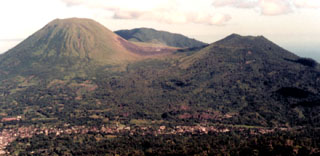Report on Lokon-Empung (Indonesia) — May 1999
Bulletin of the Global Volcanism Network, vol. 24, no. 5 (May 1999)
Managing Editor: Richard Wunderman.
Lokon-Empung (Indonesia) March-May included variable seismicity and meager plumes
Please cite this report as:
Global Volcanism Program, 1999. Report on Lokon-Empung (Indonesia) (Wunderman, R., ed.). Bulletin of the Global Volcanism Network, 24:5. Smithsonian Institution. https://doi.org/10.5479/si.GVP.BGVN199905-266100
Lokon-Empung
Indonesia
1.3644°N, 124.7992°E; summit elev. 1580 m
All times are local (unless otherwise noted)
During 9 March-24 May visual observations suggested stable conditions, with a "white ash plume" rising 25-75 m above the crater rim. But the seismic record showed extreme variation. Between 9 March and 23 March, volcanic A-type events increased from 7 to 53 and volcanic B-type events rose from 15 to 64. Tectonic events decreased from 34 to 17 in that same period. During the week of 23-29 March event numbers dropped to 23 for A-type and 43 for B-type. Tectonic events rose to 35. Weekly event incidence declined in May, hovering under 10 for A-type, under 20 for B-type, and under 25 for tectonic.
Geological Summary. The Lokong-Empung volcanic complex, rising above the plain of Tondano in North Sulawesi, includes four peaks and an active crater. Lokon, the highest peak, has a flat craterless top. The morphologically younger Empung cone 2 km NE has a 400-m-wide, 150-m-deep crater that erupted last in the 18th century. A ridge extending 3 km WNW from Lokon includes the Tatawiran and Tetempangan peaks. All eruptions since 1829 have originated from Tompaluan, a 150 x 250 m crater in the saddle between Lokon and Empung. These eruptions have primarily produced small-to-moderate ash plumes that sometimes damaged croplands and houses, but lava-dome growth and pyroclastic flows have also occurred.
Information Contacts: Volcanological Survey of Indonesia (VSI), Jalan Diponegoro No. 57, Bandung 40122, Indonesia (URL: http://www.vsi.esdm.go.id/).

